Leadership and Ethical Behaviour: Groups, Teams, Leadership Styles
VerifiedAdded on 2022/08/23
|5
|1030
|19
Essay
AI Summary
This essay delves into the concepts of leadership and ethical behavior within organizational settings, focusing on the distinctions between groups and teams. It defines a group as a collection of individuals interacting independently, primarily for information sharing and decision-making, while a team is characterized by collective accountability and interdependence. The essay highlights the differences in leadership approaches needed for each, emphasizing that groups often have a single leader, while teams may have multiple leaders and share responsibility. It explores the different leadership attributes required for each scenario, such as integrity, influence, empathy, and positivity for group leaders, and humility, resilience, vision, and accountability for team leaders. Ultimately, the essay concludes that effective leadership styles are crucial for managing both groups and teams, and that these styles must align with the unique characteristics and objectives of each to ensure organizational success.
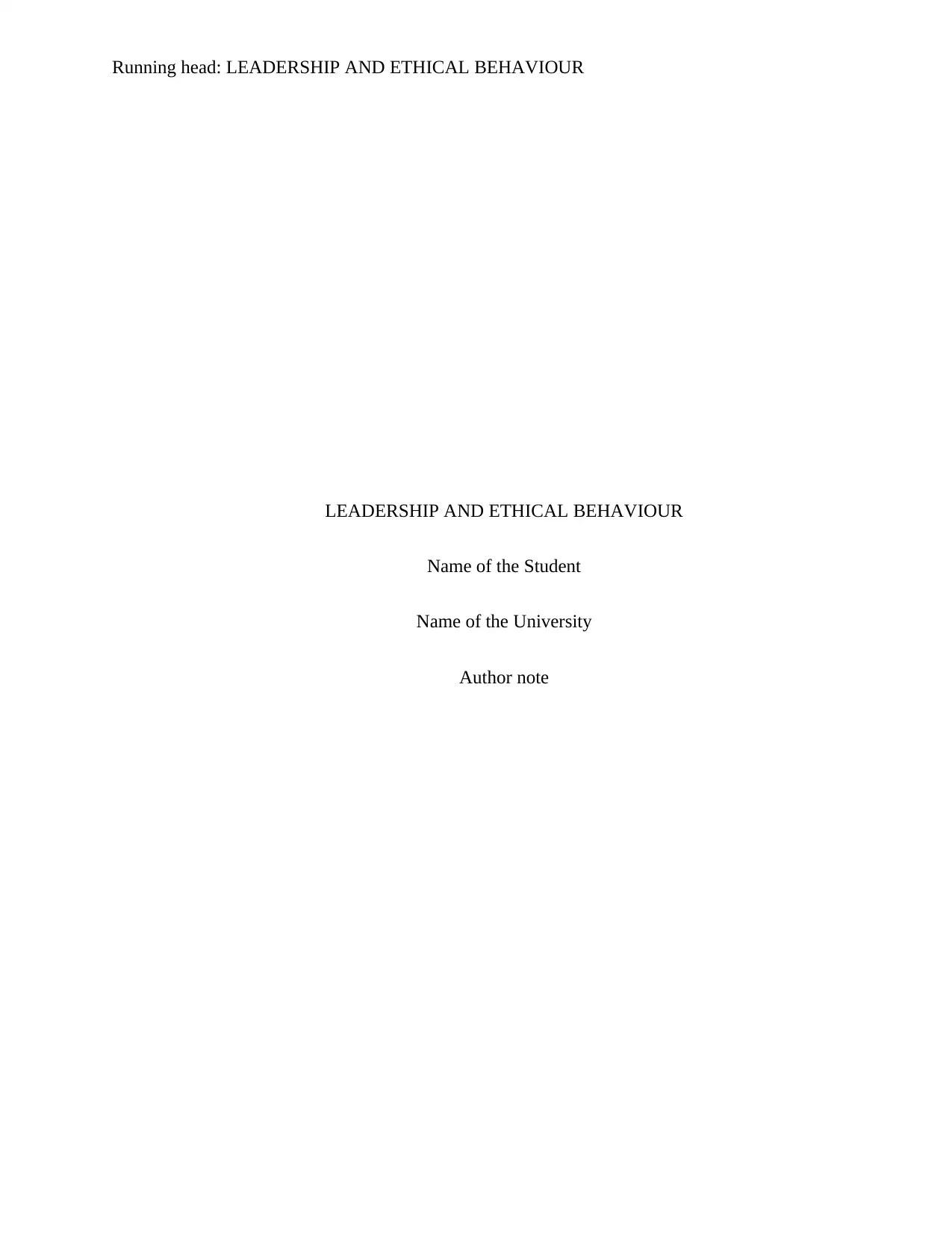
Running head: LEADERSHIP AND ETHICAL BEHAVIOUR
LEADERSHIP AND ETHICAL BEHAVIOUR
Name of the Student
Name of the University
Author note
LEADERSHIP AND ETHICAL BEHAVIOUR
Name of the Student
Name of the University
Author note
Paraphrase This Document
Need a fresh take? Get an instant paraphrase of this document with our AI Paraphraser
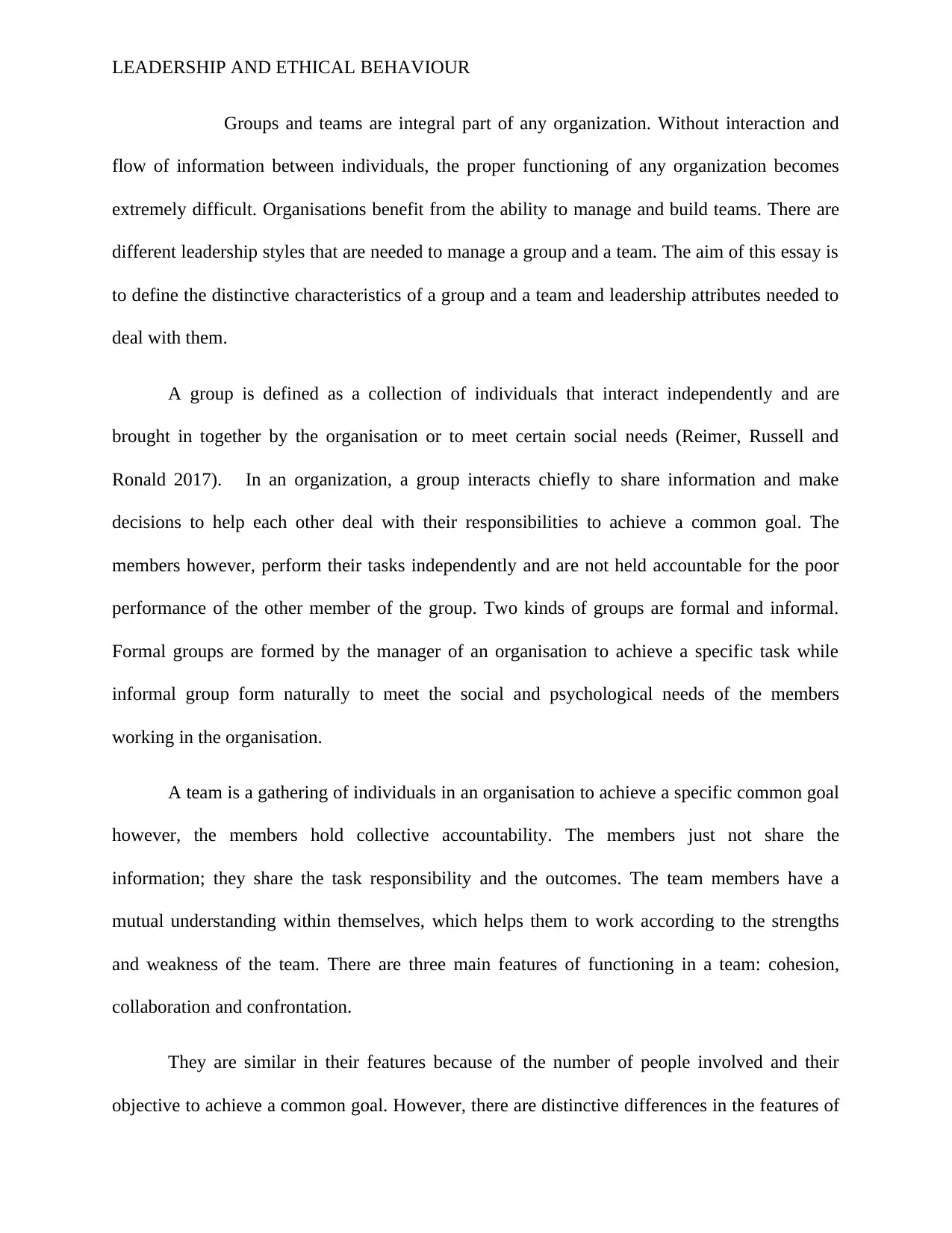
LEADERSHIP AND ETHICAL BEHAVIOUR
Groups and teams are integral part of any organization. Without interaction and
flow of information between individuals, the proper functioning of any organization becomes
extremely difficult. Organisations benefit from the ability to manage and build teams. There are
different leadership styles that are needed to manage a group and a team. The aim of this essay is
to define the distinctive characteristics of a group and a team and leadership attributes needed to
deal with them.
A group is defined as a collection of individuals that interact independently and are
brought in together by the organisation or to meet certain social needs (Reimer, Russell and
Ronald 2017). In an organization, a group interacts chiefly to share information and make
decisions to help each other deal with their responsibilities to achieve a common goal. The
members however, perform their tasks independently and are not held accountable for the poor
performance of the other member of the group. Two kinds of groups are formal and informal.
Formal groups are formed by the manager of an organisation to achieve a specific task while
informal group form naturally to meet the social and psychological needs of the members
working in the organisation.
A team is a gathering of individuals in an organisation to achieve a specific common goal
however, the members hold collective accountability. The members just not share the
information; they share the task responsibility and the outcomes. The team members have a
mutual understanding within themselves, which helps them to work according to the strengths
and weakness of the team. There are three main features of functioning in a team: cohesion,
collaboration and confrontation.
They are similar in their features because of the number of people involved and their
objective to achieve a common goal. However, there are distinctive differences in the features of
Groups and teams are integral part of any organization. Without interaction and
flow of information between individuals, the proper functioning of any organization becomes
extremely difficult. Organisations benefit from the ability to manage and build teams. There are
different leadership styles that are needed to manage a group and a team. The aim of this essay is
to define the distinctive characteristics of a group and a team and leadership attributes needed to
deal with them.
A group is defined as a collection of individuals that interact independently and are
brought in together by the organisation or to meet certain social needs (Reimer, Russell and
Ronald 2017). In an organization, a group interacts chiefly to share information and make
decisions to help each other deal with their responsibilities to achieve a common goal. The
members however, perform their tasks independently and are not held accountable for the poor
performance of the other member of the group. Two kinds of groups are formal and informal.
Formal groups are formed by the manager of an organisation to achieve a specific task while
informal group form naturally to meet the social and psychological needs of the members
working in the organisation.
A team is a gathering of individuals in an organisation to achieve a specific common goal
however, the members hold collective accountability. The members just not share the
information; they share the task responsibility and the outcomes. The team members have a
mutual understanding within themselves, which helps them to work according to the strengths
and weakness of the team. There are three main features of functioning in a team: cohesion,
collaboration and confrontation.
They are similar in their features because of the number of people involved and their
objective to achieve a common goal. However, there are distinctive differences in the features of
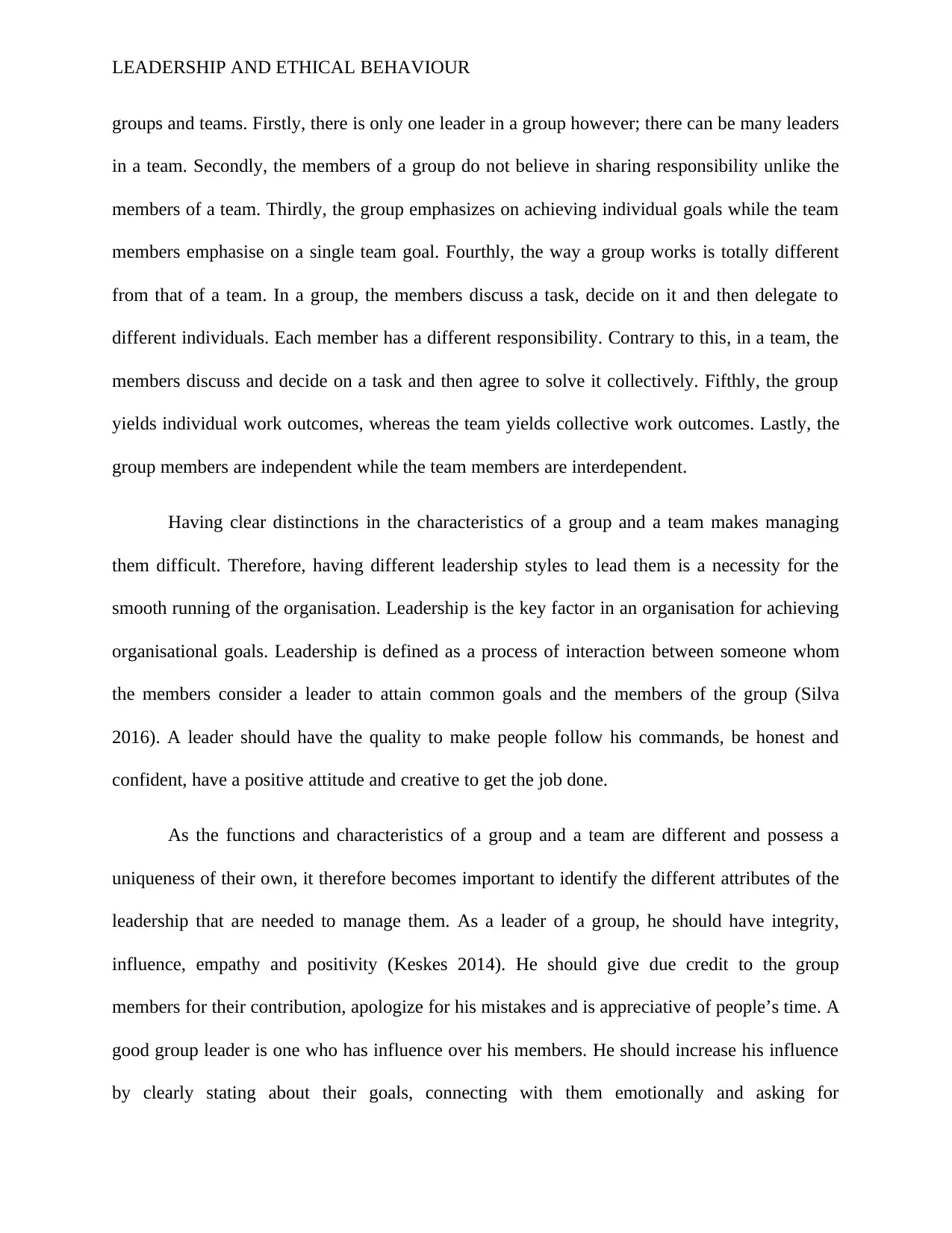
LEADERSHIP AND ETHICAL BEHAVIOUR
groups and teams. Firstly, there is only one leader in a group however; there can be many leaders
in a team. Secondly, the members of a group do not believe in sharing responsibility unlike the
members of a team. Thirdly, the group emphasizes on achieving individual goals while the team
members emphasise on a single team goal. Fourthly, the way a group works is totally different
from that of a team. In a group, the members discuss a task, decide on it and then delegate to
different individuals. Each member has a different responsibility. Contrary to this, in a team, the
members discuss and decide on a task and then agree to solve it collectively. Fifthly, the group
yields individual work outcomes, whereas the team yields collective work outcomes. Lastly, the
group members are independent while the team members are interdependent.
Having clear distinctions in the characteristics of a group and a team makes managing
them difficult. Therefore, having different leadership styles to lead them is a necessity for the
smooth running of the organisation. Leadership is the key factor in an organisation for achieving
organisational goals. Leadership is defined as a process of interaction between someone whom
the members consider a leader to attain common goals and the members of the group (Silva
2016). A leader should have the quality to make people follow his commands, be honest and
confident, have a positive attitude and creative to get the job done.
As the functions and characteristics of a group and a team are different and possess a
uniqueness of their own, it therefore becomes important to identify the different attributes of the
leadership that are needed to manage them. As a leader of a group, he should have integrity,
influence, empathy and positivity (Keskes 2014). He should give due credit to the group
members for their contribution, apologize for his mistakes and is appreciative of people’s time. A
good group leader is one who has influence over his members. He should increase his influence
by clearly stating about their goals, connecting with them emotionally and asking for
groups and teams. Firstly, there is only one leader in a group however; there can be many leaders
in a team. Secondly, the members of a group do not believe in sharing responsibility unlike the
members of a team. Thirdly, the group emphasizes on achieving individual goals while the team
members emphasise on a single team goal. Fourthly, the way a group works is totally different
from that of a team. In a group, the members discuss a task, decide on it and then delegate to
different individuals. Each member has a different responsibility. Contrary to this, in a team, the
members discuss and decide on a task and then agree to solve it collectively. Fifthly, the group
yields individual work outcomes, whereas the team yields collective work outcomes. Lastly, the
group members are independent while the team members are interdependent.
Having clear distinctions in the characteristics of a group and a team makes managing
them difficult. Therefore, having different leadership styles to lead them is a necessity for the
smooth running of the organisation. Leadership is the key factor in an organisation for achieving
organisational goals. Leadership is defined as a process of interaction between someone whom
the members consider a leader to attain common goals and the members of the group (Silva
2016). A leader should have the quality to make people follow his commands, be honest and
confident, have a positive attitude and creative to get the job done.
As the functions and characteristics of a group and a team are different and possess a
uniqueness of their own, it therefore becomes important to identify the different attributes of the
leadership that are needed to manage them. As a leader of a group, he should have integrity,
influence, empathy and positivity (Keskes 2014). He should give due credit to the group
members for their contribution, apologize for his mistakes and is appreciative of people’s time. A
good group leader is one who has influence over his members. He should increase his influence
by clearly stating about their goals, connecting with them emotionally and asking for
⊘ This is a preview!⊘
Do you want full access?
Subscribe today to unlock all pages.

Trusted by 1+ million students worldwide
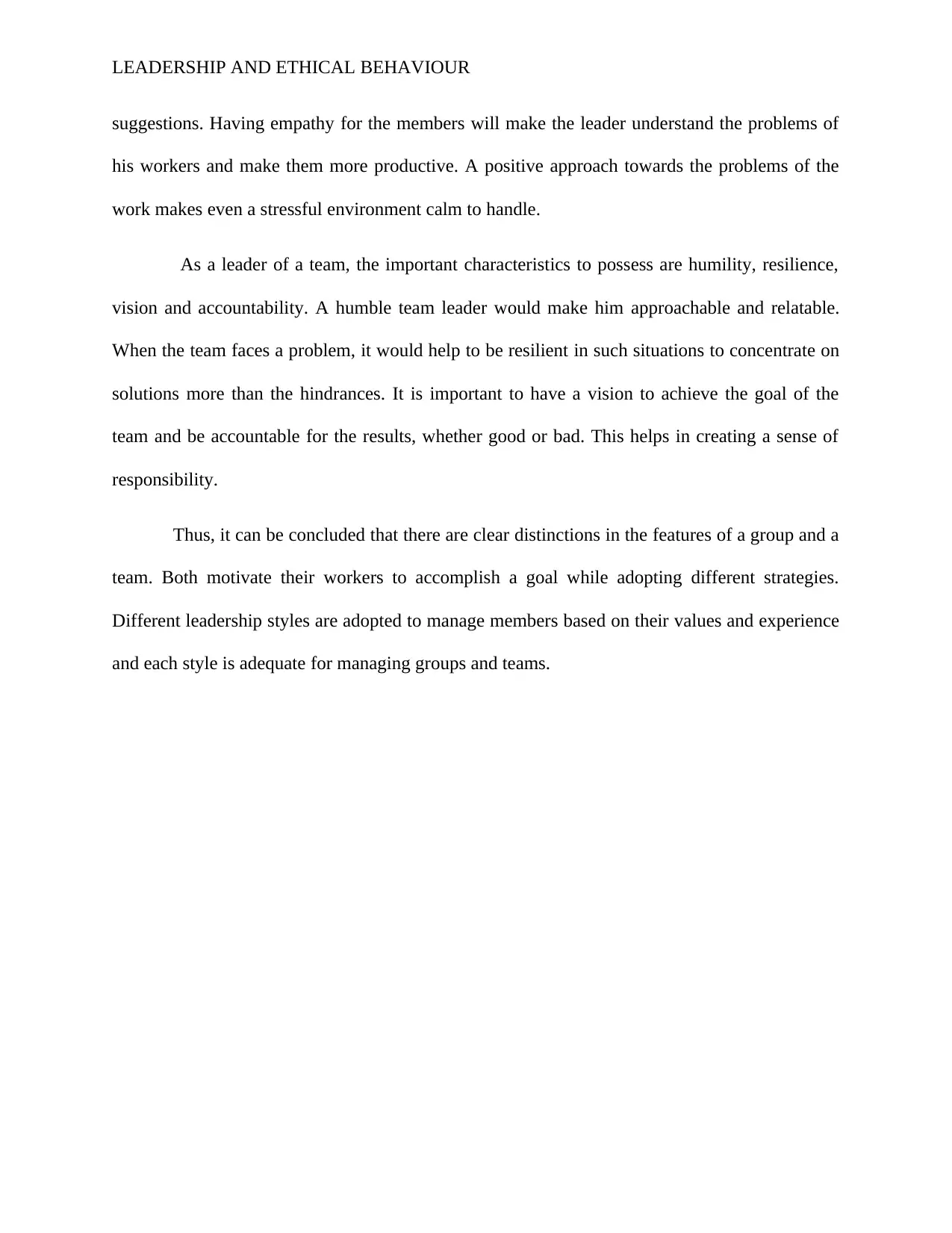
LEADERSHIP AND ETHICAL BEHAVIOUR
suggestions. Having empathy for the members will make the leader understand the problems of
his workers and make them more productive. A positive approach towards the problems of the
work makes even a stressful environment calm to handle.
As a leader of a team, the important characteristics to possess are humility, resilience,
vision and accountability. A humble team leader would make him approachable and relatable.
When the team faces a problem, it would help to be resilient in such situations to concentrate on
solutions more than the hindrances. It is important to have a vision to achieve the goal of the
team and be accountable for the results, whether good or bad. This helps in creating a sense of
responsibility.
Thus, it can be concluded that there are clear distinctions in the features of a group and a
team. Both motivate their workers to accomplish a goal while adopting different strategies.
Different leadership styles are adopted to manage members based on their values and experience
and each style is adequate for managing groups and teams.
suggestions. Having empathy for the members will make the leader understand the problems of
his workers and make them more productive. A positive approach towards the problems of the
work makes even a stressful environment calm to handle.
As a leader of a team, the important characteristics to possess are humility, resilience,
vision and accountability. A humble team leader would make him approachable and relatable.
When the team faces a problem, it would help to be resilient in such situations to concentrate on
solutions more than the hindrances. It is important to have a vision to achieve the goal of the
team and be accountable for the results, whether good or bad. This helps in creating a sense of
responsibility.
Thus, it can be concluded that there are clear distinctions in the features of a group and a
team. Both motivate their workers to accomplish a goal while adopting different strategies.
Different leadership styles are adopted to manage members based on their values and experience
and each style is adequate for managing groups and teams.
Paraphrase This Document
Need a fresh take? Get an instant paraphrase of this document with our AI Paraphraser
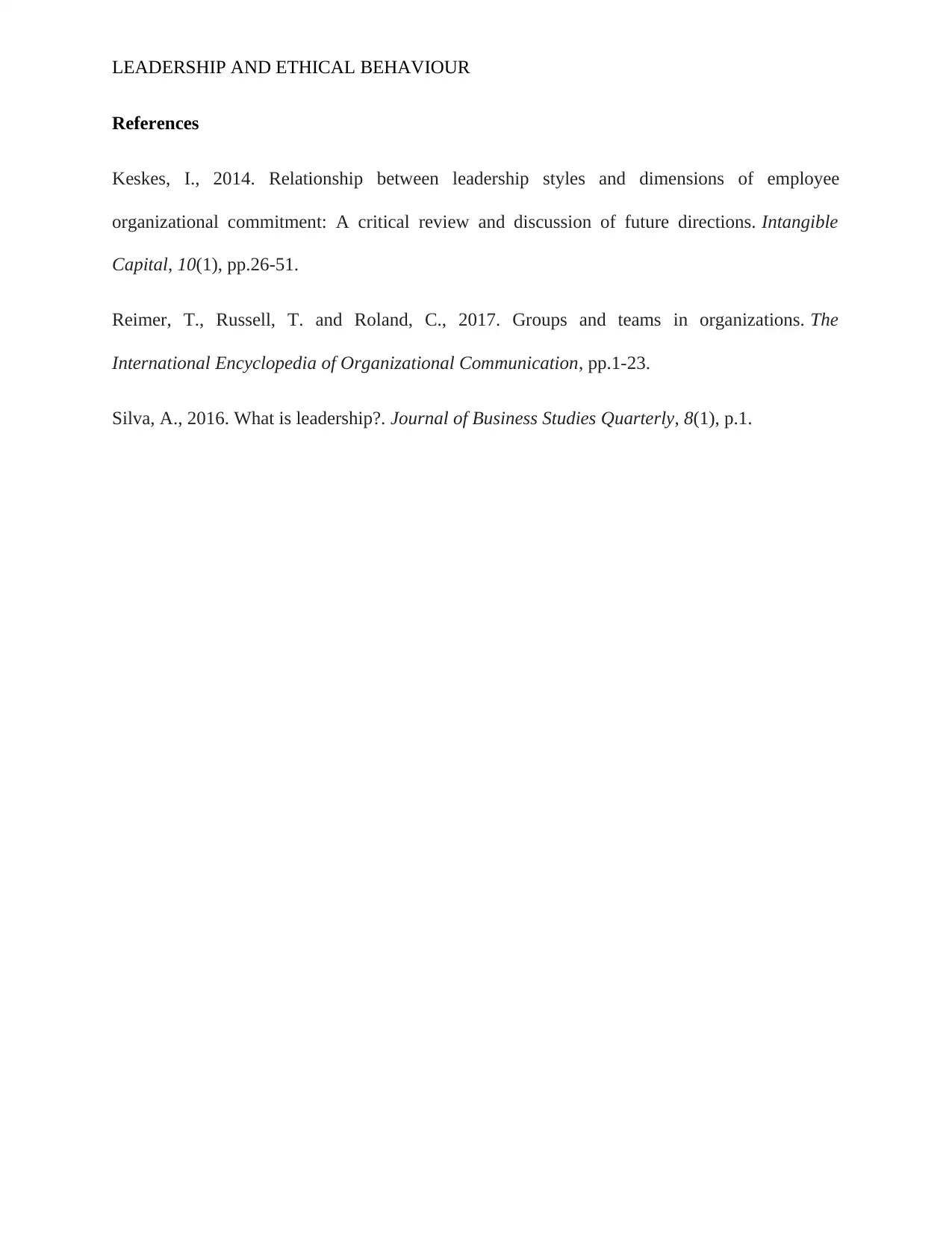
LEADERSHIP AND ETHICAL BEHAVIOUR
References
Keskes, I., 2014. Relationship between leadership styles and dimensions of employee
organizational commitment: A critical review and discussion of future directions. Intangible
Capital, 10(1), pp.26-51.
Reimer, T., Russell, T. and Roland, C., 2017. Groups and teams in organizations. The
International Encyclopedia of Organizational Communication, pp.1-23.
Silva, A., 2016. What is leadership?. Journal of Business Studies Quarterly, 8(1), p.1.
References
Keskes, I., 2014. Relationship between leadership styles and dimensions of employee
organizational commitment: A critical review and discussion of future directions. Intangible
Capital, 10(1), pp.26-51.
Reimer, T., Russell, T. and Roland, C., 2017. Groups and teams in organizations. The
International Encyclopedia of Organizational Communication, pp.1-23.
Silva, A., 2016. What is leadership?. Journal of Business Studies Quarterly, 8(1), p.1.
1 out of 5
Related Documents
Your All-in-One AI-Powered Toolkit for Academic Success.
+13062052269
info@desklib.com
Available 24*7 on WhatsApp / Email
![[object Object]](/_next/static/media/star-bottom.7253800d.svg)
Unlock your academic potential
Copyright © 2020–2025 A2Z Services. All Rights Reserved. Developed and managed by ZUCOL.




